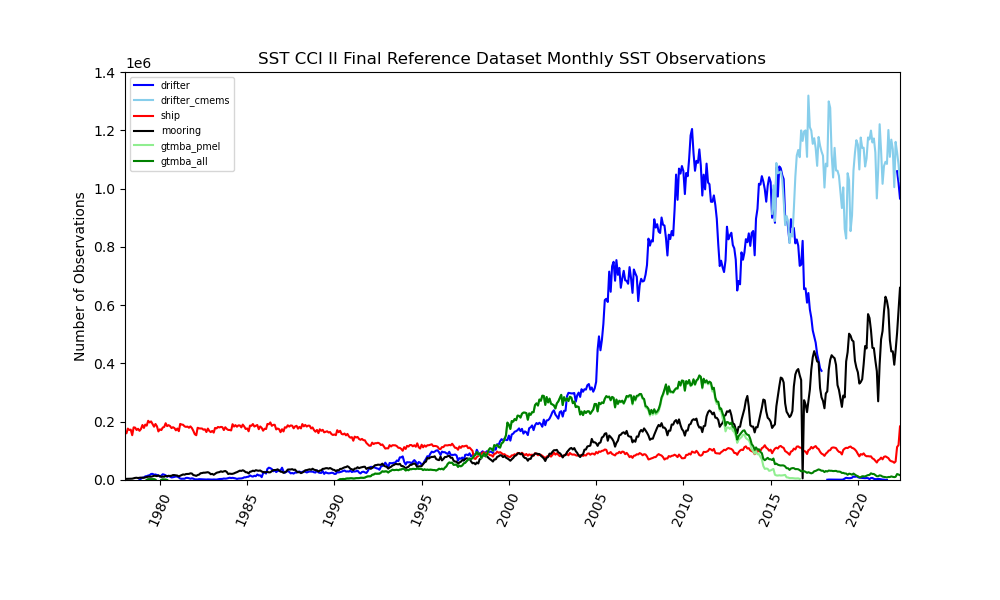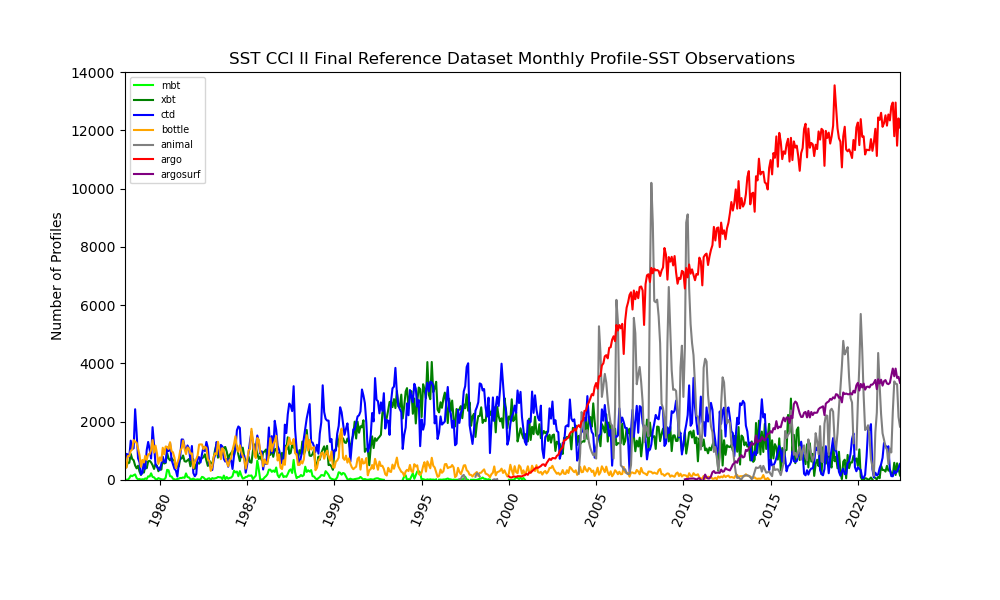Reference Data files
All file variables are 1D arrays with dimension N_OBS.
| NetCDF variable |
Description |
| Dimensions |
|
| N_OBS |
Number of observations in the file. |
| STRINGID |
Maximum length in characters of the PLAT_ID used to identify a platform. |
| Variables |
|
| OB_ID |
HadIOD database identifier for an observation. This is an integer that uniquely identifies an observation within its year and month. When combined with year and month the identifier is unique within the version of HadIOD used (e.g. HadIOD.1.2.0.0). |
| COLLECTION |
Code to identify the source of the data in HadIOD. |
| SUBCOL1 |
Code to identify sub-collections within collections. |
| SUBCOL2 |
Code to identify sub-collections within collections. |
| PROF_ID |
HadIOD database identifier for a profile. This is an integer that uniquely identifies a profile within its year and month. All observations from the same vertical profile receive the same profile ID (observations from surface-only platforms are treated as a profile with a single observation). When combined with year and month the identifier is unique within the version of HadIOD used (e.g. HadIOD.1.2.0.0) |
| PLAT_ID |
Identifier for the platform making the observations. |
| LONGITUDE |
Longitude of observation. |
| LATITUDE |
Latitude of observation. |
| YEAR |
Year of observation. |
| MONTH |
Month of observation. |
| DAY |
Day of observation. |
| HOUR |
Hour of observation. |
| MINUTE |
Minute of observation. |
| SECOND |
Second of observation. |
| DEPTH |
Depth of an observation below the surface (metres). |
| DEPTH_CORR |
Depth bias correction. Added to depth to help remove biases in reported depth. |
| SST |
Observed sea surface temperature (DegC). |
| SST_TYPE_CORR |
Temperature correction for observations made by the reference data platform type (e.g. ship, XBT). Added to observed temperature to help remove biases in the observed quantity. |
SST_TYPE_CORR_UNC |
The uncertainty in the value of SST_TYPE_CORR (std. dev.). Once the correction is applied, this describes the spread of a probability density function from which the (unknown) residual bias is drawn. The error (residual bias) associated with this uncertainty can be correlated with errors in other observations of the same platform type. |
| SST_PLAT_CORR |
Temperature correction for observations made by an individual platform (e.g. an individual ship or float), see PLAT_ID. Added to observed temperature to help remove biases in the observed quantity. |
| SST_PLAT_CORR_UNC |
The uncertainty in the value of SST_PLAT_CORR (std. dev.). Once the correction is applied, this describes the spread of a probability density function from which the (unknown) residual bias is drawn. The error (residual bias) associated with this uncertainty can be correlated with errors in other observations from the same individual platform. |
| SST_RAND_UNC |
The random measurement error uncertainty (std. dev.) associated with the observed temperature. The error associated with this uncertainty is not correlated with errors in other observations. |
| SST_COMB_UNC |
The uncertainty obtained by combining all other temperature uncertainty terms in quadrature (std. dev.). Valid when corrections have been applied.
|
| QC1 |
Observation quality flag 1.
|
| QC2 |
Observation quality flag 2.
|
| Global Attributes |
|
| description |
Description of file contents including reference data version number. |
| source |
Gives more details about the source of the data in the file, e.g. HadIOD version number and which bias correction schemes were used. |
| usage |
Gives any file-specific rules that must be followed when using the data (e.g. how bias corrections should be applied). |
| history |
States when the file was created. |
|
Variables explained
Further useful information about some of the variables is given below.
'COLLECTION', 'SUBCOL1' and 'SUBCOL2' variable values
The content of the SUBCOL1 and SUBCOL2 variables varies dependent on the value of the COLLECTION variable. This is detailed in the table below.
| Source |
COLLECTION |
SUBCOL1 |
SUBCOL2 |
| ICOADS.2.5.1, ICOADS.3.0.2 |
1, 9 |
ICOADS Deck ID* |
ICOADS Source ID* |
| EN.4.2.0, EN.4.2.1, EN.4.2.2 |
2, 4, 8 |
1=WOD13, 2=Argo GDAC, 3=GTSPP** |
N/A |
| MetDB |
3 |
N/A |
N/A |
| PMEL GTMBA (2016 download), PMEL GTMBA (2024 download) |
5, 10 |
1=TAO/TRITON, 2=PIRATA, 3=RAMA |
PMEL GTMBA SST source code*** |
| CMEMS-Coriolis |
7 |
N/A |
N/A |
*See Table AII and AIII in [Woodruff et al., 2011] and R3.0.2-imma1.pdf
**EN4 blends observations from multiple sources (see 'Data Sources').
***PMEL SST source codes:
- 0 - No sensor, no data
- 1 - Real time (telemetered mode)
- 2 - Derived from real time
- 3 - Temporally interpolated from real time
- 4 - Source code inactive at present
- 5 - Recovered from instrument RAM (delayed mode)
- 6 - Derived from RAM
- 7 - Temporally interpolated from RAM
QC Schemes
The content of the quality control variables QC1 and QC2 varies dependent on file platform type. This is detailed in the table below. It is recommended that users omit observations that fail QC. In the case of PMEL GTMBA data, users should filter based on which QC values seem most appropriate (see footnotes below).
| Type |
QC1 |
QC2 |
| drifter, ship |
Basic Met Office Hadley Centre QC*: pass=0, fail=1 |
SST tracking QC**: pass=0, fail=1 |
| CMEMS-Coriolis drifter |
Improved Met Office Hadley Centre QC***: pass=0, fail=1 |
N/A |
| mooring |
Basic Met Office Hadley Centre QC*: pass=0, fail=1 |
N/A |
| CTD, XBT, MBT, bottle, animal Argo, Argo-surface |
Basic EN4 QC****: pass=0, fail>=1 |
N/A |
| GTMBA^* (COLLECTION=1, 3 or 9) |
Basic Met Office Hadley Centre QC*: pass=0, fail=1 |
N/A |
| GTMBA^* (COLLECTION=5 or 10) |
PMEL SST flag^** |
PMEL position flag^*** |
*The Met Office Hadley Centre QC suite used for the ICOADS observations comprises basic sanity checks, position track check, climatology check and buddy check. If any of the individual checks fail, the QC flag is set to fail.
**The SST track check used for ICOADS.2.5.1 is an updated version of the QC checks described in Atkinson et al. [2013]. SSTs from individual drifters and ships are tracked against a satellite-based reference and persistently poor quality observations are flagged. Position reports are used to flag buoys that have run aground or been picked-up. The coverage of the check is 1986-2015.
***An updated version of the Met Office Hadley Centre QC suite (MDS4) became available for the addition of CMEMS observations into HadIOD. This performs a similar suite of checks to the previous suite (MDS3) used for the ICOADS observations(*) but with improvements to the performance of checks such as the track, climatology and buddy checks. A repeated value check was also added.
****Profile observations have been QC'd by the EN4 system which has many individual checks (see EN4 webpages). Observations are flagged as failing if they have failed any of the EN4 checks. For profile reference data types, only observations passing QC are included in the files, with the exception of Argo-surface reference data which includes observations both passing and failing QC.
^*GTMBA2 files contain a blend of data from ICOADS (COLLECTION ID=1 or 9) and PMEL (COLLECTION ID=10). [The original GTMBA files contained a blend of data from ICOADS (COLLECTION ID=1 or 9) and PMEL (COLLECTION ID=5), in November 2016 MetDB data (COLLECTION ID=3) were used as a substitute for ICOADS.2.5.1 data)].
^**PMEL SST flags:
- 0 - datum missing
- 1 - highest quality; pre/post-deployment calibrations agree to within sensor specifications. In most cases only pre-deployment calibrations have been applied
- 2 - default quality; default value for sensors presently deployed and for sensors which were either not recovered, not calibratable when recovered, or for which pre-deployment calibrations have been determined to be invalid. In most cases, only pre-deployment calibrations have been applied.
- 3 - adjusted data; pre/post calibrations differ, or original data do not agree with other data sources (e.g., other in situ data or climatology), or original data are noisy. Data have been adjusted in an attempt to reduce the error.
- 4 - lower quality; pre/post calibrations differ, or data do not agree with other data sources (e.g. other in situ data or climatology), or data are noisy. Data could not be confidently adjusted to correct for error.
- 5 - sensor or tube failed
^***PMEL position flags:
- 0 - datum missing (notional position added based on site metadata)
- 1 - highest quality; Pre/post-deployment calibrations agree to within sensor specifications. In most cases only pre-deployment calibrations have been applied.
- 2 - default quality; default value for sensors presently deployed and for sensors which were either not recovered, not calibratable when recovered, or for which pre-deployment calibrations have been determined to be invalid. In most cases, only pre-deployment calibrations have been applied.
- 3 - adjusted data; Pre/post calibrations differ, or original data do not agree with other data sources (e.g., other in situ data or climatology), or original data are noisy. Data have been adjusted in an attempt to reduce the error.
- 4 - lower quality; Pre/post calibrations differ, or data do not agree with other data sources (e.g., other in situ data or climatology), or data are noisy. Data could not be confidently adjusted to correct for error.
- 5 - sensor or tube failed
- 7 - datum missing (median reported position added) [gtmba2 reference data only]
- 8 - has moved from deployed location
- 9 - daily drift speed exceeds .1 kts (0.05 m/s)
- >=10 - missing value(s) in-filled by linear interpolation of neighbouring values (for gaps up to and including 10-days in gtmba reference data and 20-days in gtmba2 reference data); flag value is created by taking the lowest quality indicator of the neighbouring flag values used for interpolation and adding 10 (e.g. if the two neighbouring flag values are 2 [default quality] and 9 [drift speed exceeds .1 kts] then the flag for interpolated values will be 9 + 10 = 19.
Bias correction and uncertainty variables
Bias corrections should be added to the corresponding observations, e.g.:
- SST_CORRECTED = SST + SST_TYPE_CORR + SST_PLAT_CORR
- DEPTH_CORRECTED = DEPTH + DEPTH_CORR
Further rules on applying the correctons may be given in a file's 'usage' global attribute. Do read this. For example, the 'usage' may state that "DEPTH_CORR and SST_TYPE_CORR must be applied together (and not independently)" i.e. if applying SST_TYPE_CORR to SST, then DEPTH_CORR must also be applied to DEPTH (this might be because, for example, SST corrections are made relative to some reference level).
The reference data files use the same HadIOD observation error model as the HadIOD files. The HadIOD product user guide explains the HadIOD error model and how to work with the bias corrections and uncertainties provided by HadIOD. Reading Section 2 of the user guide is strongly recommended. Because the names used for the bias correction and uncertainty variables in the reference data files differ from the variable names used in the product user guide, the table below lists which variable names are equivalent.
| Reference data variable |
HadIOD file variable |
| SST_TYPE_CORR |
temp_type_corr |
| SST_TYPE_CORR_UNC |
temp_type_corr_unc |
| SST_PLAT_CORR |
temp_plat_corr |
| SST_PLAT_CORR_UNC |
temp_plat_corr_unc |
SST_RAND_UNC |
temp_rand_unc |
| SST_COMB_UNC |
temp_comb_unc |
Bias corrections and their uncertainties are not provided for all platform types (see the product user guide). For example, SST_TYPE_CORR corrections are only provided for ship, XBT and MBT instrument types and SST_TYPE_CORR_UNC is only provided for ships. At a minimum we try to provide some estimate of uncertainty in each measurement.
|


